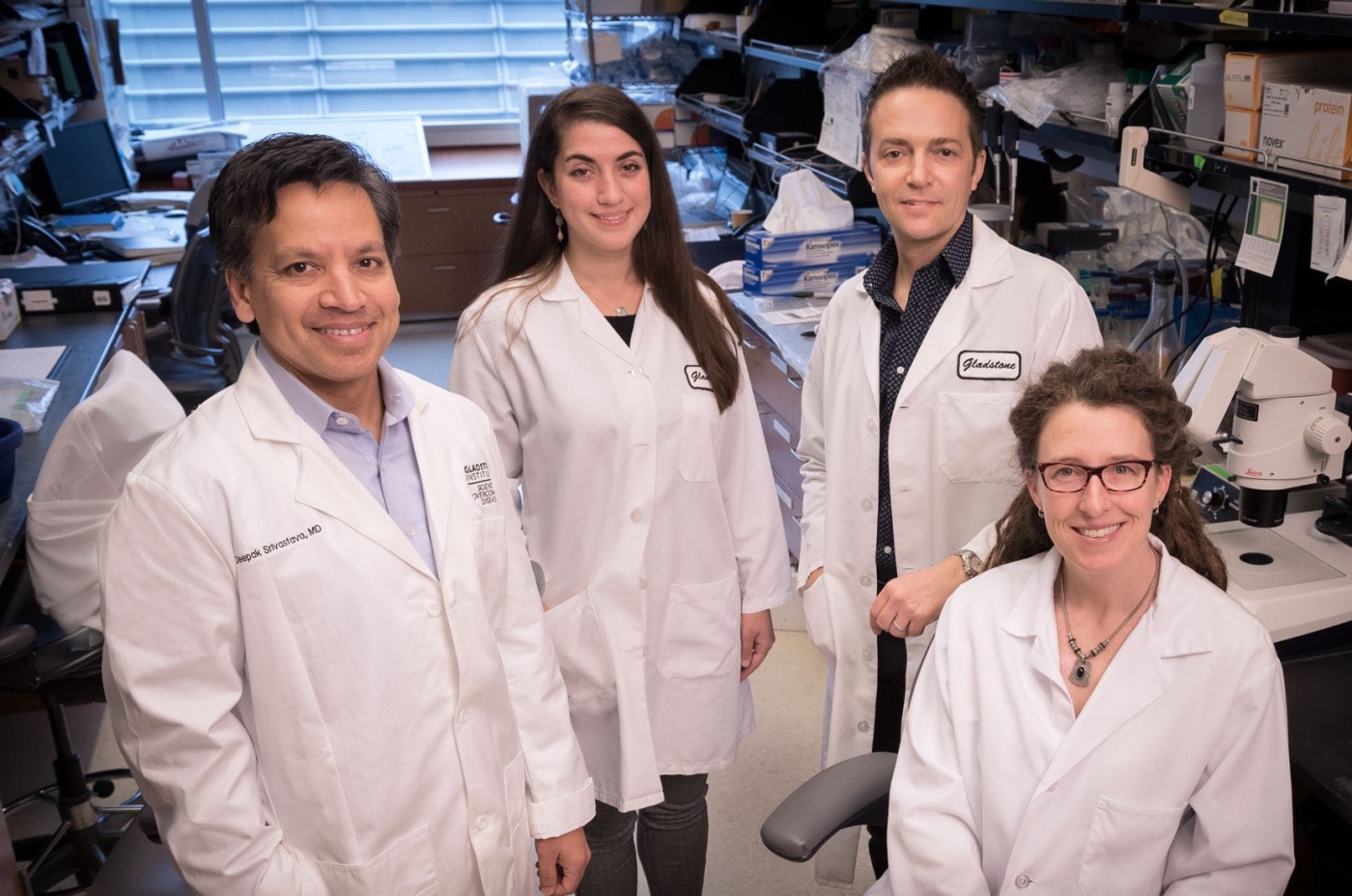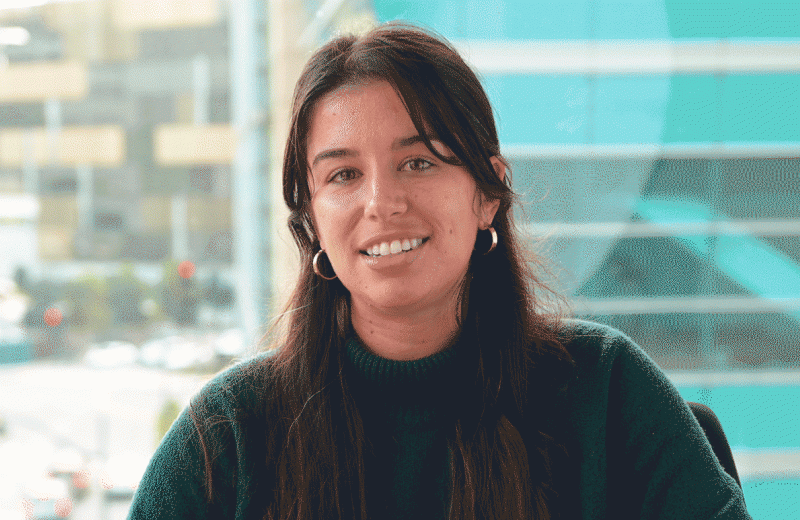Gladstone NOW: The Campaign Join Us on the Journey✕

Dr. Deepak Srivastava, Ms. Christina Theodoris, Dr. Benoit Bruneau, and Dr. Katherine Pollard identified master regulators that control calcific aortic valve disease. [Photo: Chris Goodfellow]
Collaborations have been key to Gladstone’s scientific success since its founding, and its community believes that the biggest challenges in science are better met by bringing together researchers with diverse backgrounds. Gladstone comprises a group of scientists whose concern for patients and curiosity about the fundamentals of biology converge in a distinctive and unique approach that goes beyond interdisciplinary research.
“Gladstone thrives because of its engaging environment of world-renowned researchers who bring different perspectives to critical problems,” stated Benoit Bruneau, PhD, a senior investigator at Gladstone. “It is at the intersection of disciplines that significant progress is made.”
In addition to Bruneau’s lab, the labs of Deepak Srivastava, MD, and Katherine Pollard, PhD, combined their expertise to expand the capabilities of an individual lab and work together as a fully integrated team. The study was published in the journal Cell on March 12, 2015.
“These discoveries were enabled by the team approach to science at Gladstone, with three labs contributing diverse expertise and working side by side,” stated Dr. Pollard, whose lab brought computational modeling expertise to understand the vast data that was collected. “I look forward to building upon this collaboration in the future.”
The team included first author Christina Theodoris, an MD/PhD student who was co-mentored by Drs. Srivastava, Bruneau, and Pollard, and second author Molong Li, a student working closely with both the Srivastava and Pollard labs. This deeply integrated team worked seamlessly to unravel the basis for calcific aortic valve disease. CAVD, the third leading cause of heart disease, affects nearly 1.5 million people and results in 100,000 surgeries for heart-valve replacements in the United States every year. For unknown reasons, CAVD occurs even more commonly in people born with an abnormality of the aortic valve in which there are only two leaflets instead of three—a cardiac birth defect in 1% of the population worldwide.
CAVD is a slowly progressive disorder. In some cases, the heart valve is just thickened, but in others, it can harden by a process called calcification that is similar to that when bone is made. When the valve hardens, blood flow is impeded over time. As we age, the calcification can also occur in our arteries and lead to diminished blood flow. Scientists and physicians have long recognized this as a major problem, but they do not yet understand why and how to prevent it.
In previous studies, The Srivastava lab showed that mutations in the gene, NOTCH1, cause birth defects that affect the heart valve and cause the calcification to take place sooner. Interestingly, even if only one of the two copies of the gene was mutated, NOTCH1 levels decreased and led to disease.
To understand how and why, the team used the technology developed by Dr. Shinya Yamanaka. They reprogrammed adult skin cells from patients with NOTCH1 mutations into a kind of stem cell called induced pluripotent stem cells (iPSCs). They then transformed these iPSCs into endothelial cells, which line heart valves and blood vessels. They compared healthy cells to those that came from the CAVD patients and mapped the changes as the endothelial cells developed. They found that blood flow puts a shear stress on the valve tissue that normally protects the valve from calcification by triggering NOTCH1 to turn on in the cells that line the valve. When cells had mutations in NOTCH1, however, shear stress failed to protect the valve and, instead, the cells activated a detrimental gene program that drives bone formation. Remarkably, the team was able to map the gene networks involved in this disease to pinpoint targets that could reverse the effect.
“We identified two master regulators within the gene network that are disrupted in CAVD,” said Ms. Theodoris. “When we manipulated these master regulators, the gene network returned back towards normal, suggesting that we might be able to therapeutically target these regulators to delay or prevent the progression of CAVD.”
“Identifying these master regulators is a big step in treating CAVD, not just in people with the NOTCH1 mutation at birth, but also in other patients who experience calcification in their valves and arteries,” said Dr. Srivastava. “Now that we understand how calcification occurs, we hope to learn how to prevent it and then extend this knowledge to other forms of cardiovascular disease, such as atherosclerosis. We are now collaborating with Sheng Ding, PhD, a chemist at Gladstone, to find a drug-like compound that could correct the abnormality in patient cells.”
Support Discovery Science
Your gift to Gladstone will allow our researchers to pursue high-quality science, focus on disease, and train the next generation of scientific thought leaders.
CIRM Awards $7.5 Million in Discovery Grants to Gladstone Investigators
CIRM Awards $7.5 Million in Discovery Grants to Gladstone Investigators
Two ambitious research projects led by Gladstone investigators are boosted by funds from the California Institute for Regenerative Medicine.
Grants News Release Congenital Heart Disease Cardiovascular Disease Bruneau Lab Conklin Lab CRISPR/Gene Editing Human Genetics Regenerative MedicineMatters of the Heart: A Conversation with Gladstone’s Benoit Bruneau
Matters of the Heart: A Conversation with Gladstone’s Benoit Bruneau
Bruneau, director of the Gladstone Institute of Cardiovascular Disease, shares exciting recent advances in heart research and talks about the impact of predictive AI.
Gladstone Experts Heart Failure Cardiovascular Disease Alexanian Lab Bruneau Lab Pollard Lab Theodoris Lab AIMeet Gladstone: Emily Bulger
Meet Gladstone: Emily Bulger
Graduate Student Emily Bulger describes her work in the Bruneau Lab, her family roots in science, and the scientist she'd like to have a conversation with
Profile Bruneau Lab



